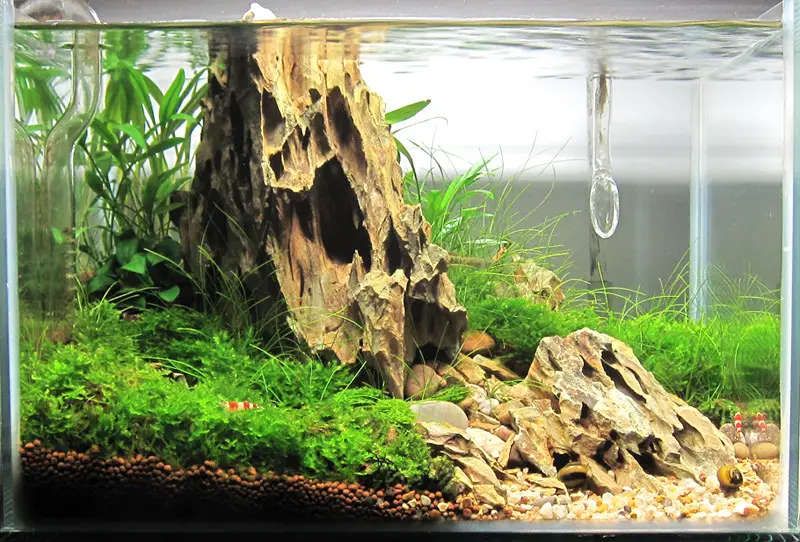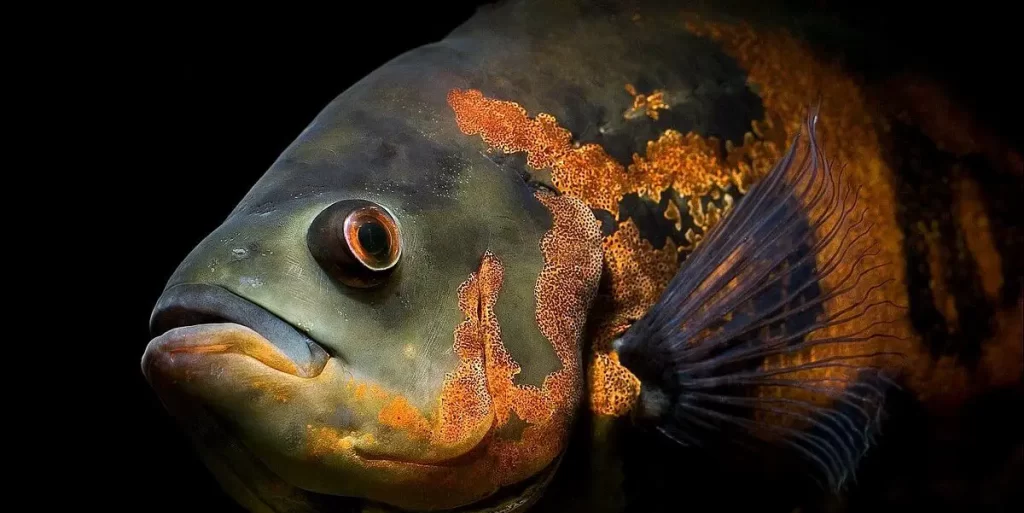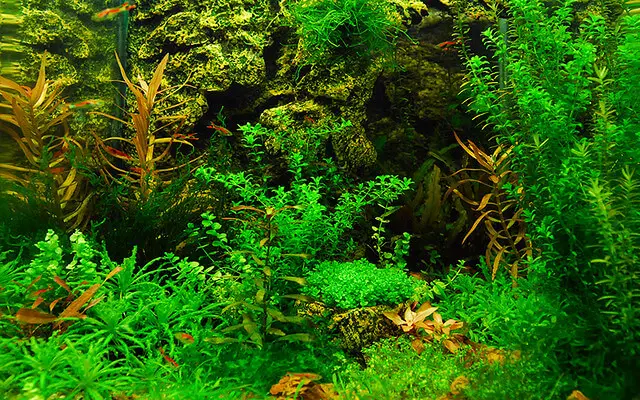The following article How to Adjust pH in Fish Tank will help you to maintain your aquarium’s pH level. Most fish will thrive in a wide range of pH, usually from low pH levels to high pH levels. Different fish have different ideal pH requirements. Some fish prefer pH level as low as 5.0 and others may prefer their pH level as high as 8.5.
Correct pH for your Fish Tank

- Saltwater fish thrive with a pH of 8.0 to 8.3.
- Many of the tropical fish will do fine from 6.5 to 7.5.
- Freshwater fish thrive with a pH of 5.5 and 7.5.
If you are lowering your pH, you should add acids to the water, as this acid neutralizes all the bases in the water, the water becomes neutral. As you add more acid to the water, the pH continues to drop and the water begins becoming acidic. Repeat it until the pH level is stable.
You should never make a sudden change in pH level because fish will not be able to handle a sudden change in the pH level and may die. Always increase or decrease pH level slowly and steadily according to the needs.PH changes the environment in the aquarium, even if the level of pH is increased or decreased in certain portions the fishes will face difficulty in surviving. Different fishes are adapted to their habitat water so they need specific water pH levels so that they can live properly without any problem.
High acidic property can lead to highly toxic water and it leads to an unbalance in the pH level so, you should regularly check the toxic level of the water. Regularly checking the pH level will help the fish to live a long life without any problem. This regular checking helps in maintaining a good aquarium with a good portion of healthy fishes.
Why is pH important for your aquarium?
Water chemistry plays an important role in successfully keeping an aquarium of any kind, but all tanks do not require the same water chemistry. pH plays a big part of that difference.
As the water pH increases, so do the ammonia percentage in the water and become more toxic. Ammonia extraction is also increased at higher pH levels, limiting an organism’s ability to purge itself of waste.
Maintaining an ideal pH can help fish and other aquatic animals to live longer. It is very important to maintain pH level so that stress to aquarium fish reduces to the maximum level. Different fish require a different level of pH to live healthily.
If you are going to buy a new aquarium you should know the pH of your water source, so you can increase or decrease pH level according to fish that you are going to house in the aquarium. Some fish need very narrow ranges of pH which should be taken into consideration when setting up their aquarium.
PH is one of the most critical factors of water quality which has a high impact on the aquatic animals. The test of pH level should be done twice a week which will help to maintain a good environment in the aquarium. If the pH level is below 6 then the bacteria that keeps the ammonia and toxic compounds to fish is at 0ppm and the fishes will die in a certain period of time. The ammonia level of the aquarium should be properly managed so that the pH level can be balanced. By using high-quality tools to monitor the pH level and correcting those misbalances in an appropriate way can greatly improve the chances of having a cleaner and pH balanced aquarium.
How to Adjust pH in Fish Tank
You can adjust your fishtank’s pH by either lowering your pH if it’s high. Or, raising your pH if it’s low. let us first know how to lower pH in the fish tank to adjust the pH.
How to Lower pH in the Fish Tank
RO Water
Reverse Osmosis is an efficient and effective water purification technology that removes contaminants and dissolved salts from water, making it clean and pure.
It is a system to deionize or demineralize water with the help of a semi-permeable membrane.
RO helps to remove the polluted water, which contains a level of nitrate, phosphate, and silicate. This helps to maintain a good environment in the aquarium.
Using Driftwood
 In an aquarium, adding a piece or two of driftwood is a great way of naturally reducing pH level in your aquarium. The course and fibrous driftwood are best for filtering water much like filtering through rocks, sand, and grit in the earth.
In an aquarium, adding a piece or two of driftwood is a great way of naturally reducing pH level in your aquarium. The course and fibrous driftwood are best for filtering water much like filtering through rocks, sand, and grit in the earth.
Driftwood may change the color of the water to solve it; there is an easy solution to soak driftwood in water for a few days before introducing it into the aquarium.
Peat Moss
The concept of using peat moss is similar to the concept and the precautions like that of driftwood. Like driftwood, peat moss can also discolor water so you should soak it in the water a few days before putting it into the aquarium. Otherwise, it will turn the color of the water into brown or yellow with time.
Almond Leaves
 Almond leaves contain several components that lower the pH level. They release tannins, which can turn the watercolor into yellow but lesser than driftwood and peat moss. These leaves are very good at filtering out the contaminants and also help to prevent or cure certain fish diseases. It releases tannins into the water to get a more pleasant and better color of the water. Different tropical fishes can live healthier if these leaves are present in the aquarium.
Almond leaves contain several components that lower the pH level. They release tannins, which can turn the watercolor into yellow but lesser than driftwood and peat moss. These leaves are very good at filtering out the contaminants and also help to prevent or cure certain fish diseases. It releases tannins into the water to get a more pleasant and better color of the water. Different tropical fishes can live healthier if these leaves are present in the aquarium.
Decrease Aeration
Decreasing aeration is the process of reducing the level of oxygen in the water so that the level of carbon IV oxide is increased. More carbon dioxide decreases the pH levels. This is a simple and cost-effective way of lowering pH in the aquarium. It helps to manage a proper portion of the oxygen level in water which will help in maintaining the pH level in the aquarium.
Adding Vinegar
There is a release of hydrogen by the acetic acid by adding vinegar to the water in the aquarium. In a period of time, bacteria and other organisms metabolize the acetate by using some of the oxygen which releases carbon IV oxide. Vinegar can also be used to clean aquarium glasses and hoods. Mixing vinegar with baking soda is also a very good method to lower the level of pH is the aquarium.
Performing Regular Water Change
By checking the water in the aquarium regularly, we can know the actual pH level of the water. By performing regular water change we can maintain a stable pH level in the aquarium. If we don’t change the water regularly then the properties of the water will change over a period of time. This will imbalance the pH level.
How to Raise pH in Fish Tank
The pH level of an aquarium can play a vital role in the health of aquatic life. If the pH level in the aquarium is too low or too high, a different problem regarding your fish health arises. The fish in your fish tank will only thrive when the pH level is maintained at a certain range required by the fish.
Using Crushed Corals
Using Crushed corals is one of the most effective methods to raise the pH level naturally. The coral shells and skeletons have a high level of calcium carbonate which gradually improves the pH level in the aquarium. To get the pH level around 6.5, we should add small, 24 tablespoons over 24 hours.
Using Limestone
 Limestone can be used in both freshwater and saltwater. It is very effective in raising the pH level of your fish tank. Because they are very rich in calcium carbonate which that water more alkaline. Limestone is calcareous, which is known to be used in both hardenings the water and increase the pH level. To achieve the best result, quality limestone must be used.
Limestone can be used in both freshwater and saltwater. It is very effective in raising the pH level of your fish tank. Because they are very rich in calcium carbonate which that water more alkaline. Limestone is calcareous, which is known to be used in both hardenings the water and increase the pH level. To achieve the best result, quality limestone must be used.
Increasing Aeration
Using proper aeration method, aquarium water gets tons of oxygen. This allows your fish to breathe property, which is very important for their good health. Without aeration, oxygen will not properly get in and carbon dioxide doesn’t get out. It helps to grow the aerobic bacteria that consume ammonia, phosphate and other compounds that should be leveled properly in the aquarium.
Adding Baking Soda
 This is another great way to raise the pH level in the aquarium. It contains different elements that help to reduce the pH level in a significant way. If the quantity of soda exceeds then fish will be killed because of exceeded baking soda.
This is another great way to raise the pH level in the aquarium. It contains different elements that help to reduce the pH level in a significant way. If the quantity of soda exceeds then fish will be killed because of exceeded baking soda.
What is an ideal pH for your Fish Tank?
There is no normal pH level that is applicable to all fish. Because different fish originated from different rivers, streams, oceans, and lakes require different pH levels. Saltwater fish prefer a pH level of 8.0 or above and freshwater fish thrive in a range lower than 8.0 i.e. somewhere between 5.4 to 7.6, depending on the species you are keeping. The ideal pH depends on the fish you’re putting in the tank and the type of freshwater fish that will go into the tank. The easiest answer is to find fish that thrive in similar pH as local water conditions. If you are living in an area with harder water (7+), then fish that will adapt to harder water can be kept in the aquarium.
The proper method to ensure that you have a balanced level of pH is by performing routine water changes. Other accumulated waste and uneaten food can also affect on the pH level of the water. So, these things need to be minimized properly. If the tap water has a good portion of elements and the pH level is balanced then no adjustments are needed. But if the tap water is impure and the pH level is imbalanced then the methods to increase and decrease the pH methods should be applied. Keeping a stable pH is very much important as cleaning an aquarium properly.
What Influences pH in an Aquarium?
Maintaining the correct pH level in an aquarium requires frequent testing and correction. And if your aquarium pH is imbalanced you should always know how to adjust pH in the fish tank. There are several elements and variables that will affect pH levels. By knowing these factors, it will help to control their impact on the balance of pH level. The pH level can be different when we change the water from the aquarium. If the water contains more hydrogen ions and hydroxide then it is said to be neutral. An increase in hydrogen will lead to a higher level of acidic property in water. Fish wastes can highly affect the pH level of an aquarium.
The concentration level is directly related to the pH level of the water. The concentration of ammonia is higher at a low level of pH and the concentration of ammonia is lower in a high level of ph. When the pH level increases, ammonium in the water is converted in toxic ammonia, which can kill the fish. Aquatic animals require the water which has a suitable pH level for living. If the pH level is not balanced then it can make fish sick, even kill them.
A decrease in the pH level is an indication that there is an excess amount of nitrite which is a result of the high rate of the dead organism, decaying foods, and plants in the aquarium. The dangerous acidic elements, ammonia or nitrate spikes should be checked properly so that it is well balanced in the pH level. If these elements are not checked properly then the pH level will be imbalanced and fish can be sick or can die because of the inadequate environment to live.
Carbon Dioxide
When carbon dioxide is dissolved in water, it forms a weak acid that will misbalance the level of pH. It can come from different sources like respiration, a decay of fish, insects, and bacteria. The proper amount of carbon dioxide is good for the growth of plants. It is the purest form of the gas so it can help pant a lot. An aquatic plant uses the dissolved carbon dioxide for the photosynthesis process.
Airborne Contaminants
Different airborne contaminants and dust can change the pH level in a significant way. This dust may contain a chemical or organic compound that is dissolved in water. This contamination process makes the water impure which leads to unsafe environments for the aquatic animals. The water absorbs the gases and becomes more acidic after interacting. When it rains the acidic property in the air mixes with the water.
Chlorine
Chlorine helps to kill any harmful bacteria or any other pathogens which we get into the water. It also makes the water cleaner and safer. The component chlorine becomes gaseous that will radically reduce pH levels. If added in a proper manner it will not affect the level of pH in the water.






